
Nonprofit Fundraising Learning
Unleash the power of your fundraising with our curated collection of educational video courses, designed for nonprofits. Step into the expansive and changing world of raising funds effectively, navigating through the proven strategies and innovative techniques that Top Nonprofit Experts shared. These video sessions will lead you on a journey to discover the art and science of persuasive storytelling, engaging donors, and mastering grant writing – to name just a few topics. Whether you are starting a new nonprofit or looking to advance an already robust fundraising program, these learning segments are packed with actionable insights and practical tools to help you reach your goals for your charity, nonprofit, or NGO.
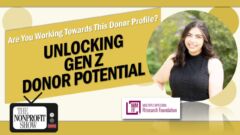
How do you win the hearts—and hands—of Gen Z donors? According to Emily Tisdale, West Coast Manager for Team for Cures at the Multiple Myeloma Research Foundation (TheMMRF.org), you stop seeing them as “the future” and start engaging them right now.
In this lively session, Julia C. Patrick explores Gen Z’s philanthropic behavior with Emily, who’s on the frontlines of volunteer and donor engagement across three major markets. Emily doesn’t mince words: “This generation is not transactional. They want to be part of the change.” That means showing up, speaking out, and yes—expecting organizations to be transparent and impact-driven.
Emily explains how COVID-era isolation shaped Gen Z’s digital-first instincts, but also fueled a hunger for purpose. Whether it’s advocacy via Instagram, fundraising through peer networks, or attending real-life charity walks, Gen Zers are ready to get involved—when the mission speaks to them. “They don’t want to just cut a check and sit back,” she adds. “They want action.”
Julia challenges common assumptions about younger donors being flaky or too young to matter. Emily pushes back with stories of college students becoming long-term supporters, and volunteers maturing into major funders. “We need to meet them where they are today,” she says. “Because where they’re going is powerful.”
The conversation covers everything from social media strategies to cross-generational mentorship. One standout idea? Pair Gen Z volunteers with seasoned ones to create a mutual growth loop. “Our high-impact volunteers can become our highest-impact donors,” Emily points out.
Whether you’re building out a peer-to-peer campaign or rethinking how you cultivate loyalty, this episode offers a smart, real-world roadmap for tapping into Gen Z’s energy and values.
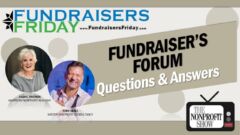
In a whirlwind of nonprofit questions from viewers, Julia C. Patrick and Tony Beall splash into the world of fundraising mysteries. "We need to diversify our funding streams," Tony begins, setting the tone for a conversation that's part strategy session, part confessional. From the complex dance of fundraising committees to the cutting-edge world of cryptocurrency donations, these nonprofit mavens dissect the industry's most pressing questions with surgical precision and infectious enthusiasm.
How do fundraising committees work with board members? Committees can serve as talent pipelines and engagement platforms, with board members actively recruiting committee members.
Should nonprofits accept cryptocurrency donations? Yes, but carefully evaluate organizational readiness, donor demographics, and infrastructure.
What's the typical fundraising performance ratio? Generally 1:5 to 1:10 for development officers, varying by specific role and organization.
Are printed annual reports still relevant? Offer both print and digital versions, tailoring to donor preferences and organizational resources.
How should fundraisers demonstrate their value? Beyond monetary metrics, highlight pipeline development, donor retention, and mission impact.
00:00:00 Show Introduction and Sponsors
00:02:08 Fundraising Committees Deep Dive
00:07:51 Cryptocurrency and Donor Advised Funds
00:14:29 Annual Report Strategies
00:19:07 Fundraiser Performance Metrics
00:28:25 Closing Remarks and Gratitude
#TheNonprofitShow #FundraisingInnovation #NonprofitStrategy

Thinking of opening a nonprofit thrift store? Before you dust off those donation bins, take a lesson from Kate Thoene, CEO of New Life Center., as she gives us a masterclass in turning a pile of secondhand shoes into sustainable impact. Spoiler: It’s not as easy as slapping a price tag on old lamps and hoping for the best.
At Hope’s Closet, the social enterprise Kate oversees, “we don’t take anything that makes you ask, ‘Should I donate this or toss it?’” That tough-love clarity is part of what keeps their thrift shop not just afloat—but thriving. From curated donation bins and strategic store layouts to voucher programs for survivors of domestic violence, Kate walks us through how her organization uses retail to empower recovery, generate unrestricted revenue, and build community loyalty.
She breaks down staff structure (a mix of full-time employees and 1,000+ volunteers), donation flow (“you need new items hitting the floor daily”), and even how color-coded tags help them cycle out stale inventory. Plus, we learn about their fruitful partnership with Big Brothers Big Sisters—where unsellable items are bought by the pound, keeping the store clutter-free and the landfill grateful.
Don’t miss how this 5,000-square-foot shop became a community engine, churning out real, trackable impact. Kate shares insights on metrics, bonus incentives, messaging at point-of-sale, and even the exciting possibility of store #2. And yes, there's a half-off sale where even the “rules” go on discount.
If you’ve ever wondered whether charity shops are worth the effort, Kate answers that with a resounding yes—as long as you’re ready to think like a retailer, hustle like a startup, and lead with mission.
"The more we sell, the more we help survivors of domestic violence." — Kate Thoene
#ThriftWithPurpose #thriftstores #TheNonprofitShow
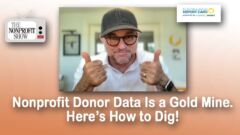
If you've ever wondered whether your nonprofit fundraising data is a treasure chest or a digital junk drawer, Greg Warner is here with a flashlight, a map, and a pickaxe. In this entertaining conversation, Greg—CEO of MarketSmart and creator of the Fundraising Report Card—joins host Julia Patrick to dissect the murky waters of metrics and help nonprofits move from guesswork to grounded strategy.
Greg kicks off with the backstory: MarketSmart’s 17-year evolution into a marketing automation firm helping nonprofits identify, qualify, and steward major and legacy donors. ‘The Fundraising Report Card’, born from this journey, now offers nonprofits a simplified yet powerful lens into donor behavior—showing not just what happened, but what it means.
Here’s the twist: until now, this tool has been free. But with over 27,000 users and a mountain of benchmark data, Greg’s team is rolling out a more robust version—with peer comparisons so relevant, they make national averages look like vague horoscopes.
And it’s about time. “Relevance creates resonance,” Greg shares, “But irrelevant data creates dissonance.” Nonprofits have long been running on emotional narratives and gut instincts. Greg invites you to reframe the conversation using donor lifetime value, retention data, and institutional memory—all quantified, all visual.
Julia comments how too many development pros spend two days prepping board reports for seven minutes of attention. Greg’s fix? Collaborative tools baked into the new version of the app, enabling real-time, cross-functional dialogue. Because why silo data when you can democratize it?
Want to stop flying blind and start mining gold? This episode is your blueprint.
#FundraisingData #DonorAnalytics #TheNonprofitShow
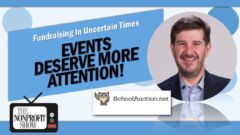
What happens when a PTA president-turned-techie disrupts the nonprofit auction world? You get Roger Devine, co-founder of SchoolAuction.net, a man on a mission to make fundraising events both profitable and meaningful. In this fast-moving conversation with host Julia Patrick, Roger doesn’t just talk events—he redefines them.
From live auctions and paddle raises to the fine art of keeping silent auctions out of the ballroom, Roger offers a field-tested guide to modern event strategy. “I want to treat a fundraiser as if it is a fundraiser—I expect to make money,” Roger declares. And he means it.
But this isn’t just about money—it’s about momentum. Events aren’t just financial tools; they’re culture-building machines. Roger explains how strategic gatherings can cultivate younger donors, lift staff morale, recognize unsung heroes (like teachers and mission staff), and pull entire communities back into connection after years of distraction.
He makes a compelling case for fixed-price purchases (think raffles, gift cards, and sign-up parties), lowering barriers to entry, and offering dignity and opportunity to every guest—whether they’re dropping $25 or $25,000.
Oh, and about those paddle raises? Roger’s advice is clear: don’t wing it with your local news anchor. A trained benefit auctioneer is essential—not just for showmanship, but because they can drive up to 50% of your total event revenue. Skip this at your peril.
Watch and you'll also learn:
· How hybrid and virtual fundraising have evolved (spoiler: most aren't fun anymore)
· How to smartly integrate consignment travel packages (hint: only if Bob Bigshot’s coming)
· Why accessibility matters—and how a volunteer ticket swap can make all the difference
Whether you're planning your first gala or overhauling your tenth, this episode will shake up your thinking. Because fundraising events shouldn't be a chaotic night of stress—they should be joyful, purposeful, and yes, wildly effective!
Join the ongoing conversation at #TheNonprofitShow
#EventFundraising #FundraisingAuctions

Explore the intersection of philanthropy, data science, and the evolving tools shaping nonprofit fundraising, with our guest, Scott Brighton, CEO of Bonterra. Bonterra, a software company serving both nonprofits and funders, processes nearly 10% of all U.S. philanthropic activity outside government sources. This scale gives Scott and his team a uniquely comprehensive vantage point to identify what truly drives growth and effectiveness in today’s nonprofit landscape.
The episode centers on Bonterra’s newly released ‘2025 Impact Report’, which identifies strategic patterns and technologies used by high-performing nonprofits. Scott explains, “We’re not just looking at the growth of philanthropy; we’re looking at what successful organizations are doing differently.” Key among those behaviors is fundraising diversification—no longer a suggestion but a necessity, especially in light of sudden disruptions like cuts to federal funding. Scott shares that some Bonterra clients saw 90% of their federal funding evaporate overnight, a stark reminder that relying on a single funding stream is risky.
Technology, and specifically AI, is positioned as the great equalizer. Scott introduces tools like “Optimized Ask,” which uses behavioral data to recommend the right donation amount for each donor, improving average donor yield by 11%. This innovation, he explains, enables nonprofits to effectively engage their long-tail donors without additional staff—something that was previously out of reach for most organizations.
Another key point Scott shares is the local nature of nonprofit growth. Despite a doubling of registered U.S. nonprofits over the last decade (now nearing two million), 90% operate with budgets under $5 million. Rather than viewing this as a challenge, Scott sees it as a feature: these hyper-local organizations are ideally positioned to address complex societal issues with intimate community knowledge. Bonterra is facilitating cross-sector collaboration among these small players to help large funders feel confident investing significant resources.
The conversation wraps with Bonterra’s bold internal campaign: “3% by 2033.” The goal is to raise the nation’s charitable giving from 2% to 3% of GDP in under a decade. Scott is optimistic—not because of software alone, which he candidly says requires more resources than many nonprofits can spare—but because of the promise of agentic AI: autonomous systems that act on data insights without human micromanagement.
This conversation shifts the frame of nonprofit operations from emotionally driven to insight-driven—a rebalancing Scott believes is essential to meet the expectations of next-generation donors. . . . “The future of fundraising isn’t just emotional—it’s intellectual,” Follow the ongoing conversation at #TheNonprofitShow
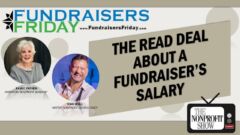
How much should a fundraiser make—and why is it still taboo to ask?
Cohosts Julia C. Patrick and Tony Beall tackle the longstanding silence around nonprofit salary transparency. “There isn’t a whole lot of trust around this topic,” says Tony, “and it’s good for us to start talking about it.” What unfolds on this Fundraiser’s Friday episode is a candid, layered discussion about job titles, compensation expectations, and the complicated politics behind who earns what—and why.
Fundraising jobs are not one-size-fits-all. As Tony explains, “There are assistant positions, manager roles, directors, officers—each with its own accountability level, not just a paycheck.” But the sector’s tendency to obscure salaries makes it difficult for professionals to map their advancement. Julia adds, “Talking about salary used to be grounds for dismissal—higher up than reporting abuse. Think about that.”
The duo explore the overlap and confusion between job titles—director vs. officer—especially across healthcare, higher ed, and arts institutions. While some roles sound loftier than others, Tony argues that “titles are often interchangeable,” driven less by function and more by organizational type.
Experience doesn’t always translate to higher pay either. “Ten years in doesn’t mean a pay jump if you’re not at the right org,” says Tony. Instead, professional development, certifications, and even microlearning now influence compensation more than tenure. The hosts underscore how nonprofits are slow to reward results: even fundraisers who exceed goals may still hit salary ceilings unless they leave for a new organization.
And it’s happening often—turnover is the sector’s open secret. With development staff staying an average of just 19 months, organizations are hemorrhaging talent due to stagnant pay structures and institutional inertia. “You can prove you’re worth it, hit all your metrics—and it still might not matter,” Tony warns.
Remote work has added fuel to the fire. Salaries are increasingly influenced by where you live, not where your nonprofit is based. “You may be doing New York-level work from Omaha—but don’t expect New York pay,” says Julia. It’s an unspoken recalibration that’s forever altered the labor equation.
For fundraisers at any stage in their career, this episode doesn’t just demystify nonprofit salaries—it demands that we start having these conversations openly and often.
00:00:00 Welcome and intro
00:02:00 Why salary talk is still taboo
00:03:30 Fundraising job title levels
00:05:15 Accountability vs. salary
00:07:00 Director vs. Officer roles
00:08:45 Career advancement limitations
00:11:00 Should salaries be posted?
00:14:00 Location-based salary differences
00:17:00 Experience vs. skillset
00:20:30 Education and certifications
00:22:00 Proving value through metrics
00:26:00 Who pays the most in the sector?
00:27:30 Passion vs. paycheck
00:28:50 How to keep the salary convo going
Follow the ongoing conversation at #TheNonprofitShow
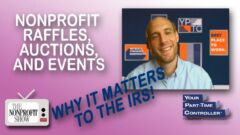
Is your nonprofit planning a gala, auction, or bingo night? Before you book the venue or sell that first ticket, there’s one essential step you may be skipping—looping in your accounting team. In this eye-opening conversation Dan Tritch, Director at Your Part-Time Controller, issues a clear directive to fundraisers: “Talk to your accountants before you plan your fundraising event—every time.”
Dan doesn’t just talk shop—he brings real consequences to light. From misclassifying revenue to unknowingly triggering tax liabilities, organizations that treat finance as an afterthought in event planning can wind up with costly surprises. Fundraising isn’t just about generating revenue—it’s about how that revenue is earned, tracked, and reported.
Dan breaks fundraising activities into three financial stages: 1) procurement, 2) day-of-event, and 3) post-event. He warns that mishandling sponsor agreements, mislabeling advertising, or ignoring unrelated business income tax (UBIT) can derail even the most successful-looking event. That free week in a beach condo or donated diamond necklace? It may be worth more in red tape than revenue—unless properly accounted for.
And then there's gaming. Raffles, casino nights, and even simple bingo games carry serious regulatory implications that vary by state and can prompt IRS attention. Dan urges nonprofits to consult their tax accountants and state gaming authorities before launching any game-based campaign.
The episode also tackles the misperception that all earned income equals fundraising. Not so, says Dan. Ticket sales, service fees, and campaign contributions each carry distinct accounting requirements. Getting it wrong can distort financial statements and complicate audits.
Dan’s insights go beyond warnings—they’re a roadmap for success. He outlines best practices such as separating earned income from contributions, issuing accurate receipts, tracking in-kind donations, and deferring revenue until the event occurs. His message is clear: solid financial planning empowers smarter fundraising, not just safer bookkeeping.
00:00:00 Welcome and intro with Dan Tritch
00:04:45 Why fundraising events are misunderstood financially
00:05:59 What truly counts as fundraising (and what doesn’t)
00:07:41 The accounting implications of special events
00:10:08 The legal complexity of gaming-based events
00:14:13 Three financial stages of an event
00:15:01 Sponsorship vs. advertising: know the difference
00:20:30 Ticket revenue: earned income vs. contribution
00:22:58 Best practices for event accounting and receipting
00:24:13 How in-kind gifts complicate auction accounting
00:25:54 Are fundraising events even worth the effort?
00:27:32 Final advice: ask early, plan smart
Follow the ongoing conversation at #TheNonprofitShow
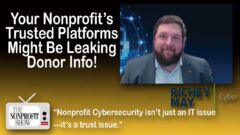
“Cybersecurity used to be the Department of ‘No’. Today, it's about enablement—how we help people work securely without getting in the way.”
Cybersecurity isn’t just an IT issue—it’s a trust issue. Michael Nouguier, Partner at Richey May’s Cybersecurity Services, joins us to discuss how nonprofits can better protect donor data, assess third-party platforms, and prepare for the inevitable breach.
Michael opens with a striking truth: “Cybersecurity is about risk—what we choose to accept, and what we work to prevent.” From this lens, this episode offers a detailed breakdown of today’s most pressing cybersecurity concerns, especially as they relate to data collection, donor privacy, and evolving threats like AI-driven attacks.
The conversation kicks off with the importance of identifying and documenting what data your organization actually collects—not just donor information, but client data, health records, payment details, and beyond. Michael stresses the danger of overlooking third-party vendors, who may have weak security protocols but still process sensitive data on your behalf.
Julia Patrick, host, presses Michael on how access control works in today’s remote-first world. His response is practical: build systems around role-based access and restrict data visibility by “need to know.” Whether you're a 5-person nonprofit or a national organization, overly broad permissions are a recipe for disaster.
Michael shares real-world examples of organizations undermining their own security—like contractors blocking ChatGPT integrations due to risk, prompting staff to email data to themselves for off-system use. It’s not just about locking systems down—it’s about enabling safer, smarter workflows that employees will actually use.
The episode wraps-up with a powerful call for scenario planning. Just like fire drills, “tabletop exercises” around cybersecurity incidents can build organizational muscle memory, reduce financial loss, and preserve your nonprofit’s reputation when—not if—a breach occurs.
If you think this topic is too technical to matter to your mission, think again. This conversation makes clear: cybersecurity is mission-critical because your donors expect trust, your clients deserve privacy, and your organization can’t afford the fallout of avoidable mistakes. Follow the ongoing conversation at #TheNonprofitShow

master class on the untapped power of volunteerism—with a call to rethink how we attract, support, and retain volunteers—led by guest expert Kirsten Wantland, Manager of Customer Best Practices and Enablement at Bloomerang,
Kirsten, who holds credentials as a Certified Nonprofit Consultant and Certified Development Executive, brings both frontline and strategic expertise. With her deep background in fundraising and nonprofit leadership, she makes a bold case for managing volunteers with the same intentionality as donors. Her rallying cry? “Recognize behaviors over capacity.”
Too many nonprofits still treat volunteer management as an afterthought—focused on day-of logistics or generic thank-yous. But Kirsten argues for a proactive, data-informed approach that starts well before a volunteer steps foot on site. From setting clear expectations in role descriptions to acknowledging service hours as contributions worth over $34.79 per hour, this learning session delivers some super strategies that can translate into real organizational value for your NPO.
Volunteers aren’t just a feel-good bonus; they are a form of human capital that, when properly stewarded, can evolve into loyal donors and long-term advocates. “If you think of someone donating 10 hours,” Kirsten explains, “you’re looking at the equivalent of nearly $350 in economic impact. How many of your donors give that much in a single gift?”
She encourages nonprofits to:
· Communicate expectations clearly and respectfully.
· Track volunteer hours just like financial contributions.
· Plan intentional follow-ups after service.
· Use personalized recognition—by name, by role, by impact.
· Share volunteer stories in annual reports and community messaging.
Kirsten also addresses a long-standing sector taboo: asking volunteers to give financially. Her advice? Let the volunteer decide. Many already feel deeply connected to the mission and are primed for deeper engagement if offered meaningful opportunities.
This is a must-watch for anyone building or revamping a volunteer program. Whether you’re a small grassroots org or a large multi-program agency, Kirsten delivered a powerful reminder: treating volunteers like integral partners, not just helpers, can boost retention, deepen engagement, and even expand your donor base.
00:00:00 Welcome and guest intro
00:01:40 Kirsten’s credentials and new role at Bloomerang
00:03:00 The impact of formal nonprofit education
00:06:20 Defining volunteer clarity and role expectations
00:09:30 Orientation and onboarding strategies
00:11:00 Recognizing volunteers effectively
00:14:20 Tracking volunteer hours and value
00:16:30 Volunteers as non-monetary donors
00:20:00 Creating a follow-up plan post-volunteering
00:22:00 Should volunteers be asked for donations?
00:24:00 Personalized engagement based on behavior
00:27:00 Volunteer storytelling and long-term commitment
Follow the ongoing conversation at #TheNonprofitShow
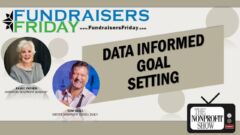
If setting fundraising goals gives you a headache, this episode of Fundraisers Friday is the relief you didn’t know you needed. Our cohosts unpack the complexities of data-informed goal setting with a mix of practicality, good humor, and insight born from the frontlines of nonprofit leadership.
Right from the start, Tony Beall shares his signature "Magic 3" approach: “Three years of past performance is the sweet spot. Go further back, and the trends get stale.” It's not about choosing arbitrary numbers or crossing fingers for a miracle. It's about examining actual fundraising performance across all your revenue channels—events, major gifts, recurring donations—and understanding what those data points mean for the future.
“Don’t just pick a number and yell ‘Bingo!’” Tony quips, debunking the idea that fundraising targets are about gut feelings or guesswork. Instead, he offers a framework where budget goals are built from pipeline reality, retention rates, and channel-specific growth capacity.
Julia Patrick adds, “A lot of boards still think in binary—hit the number, you're a hero; miss it, you’re out. But it's so much more layered than that.” The two discuss how capacity building (staffing, tech, infrastructure) is too often overlooked in budgeting—even though it's the engine that powers results.
The show also digs into predictive metrics, the future of AI tools in analysis, and the shifting cultural values around growth for growth’s sake—and packed with actionable advice, real-world insight, and a fresh reminder that data isn’t dry—it’s your path to smarter, saner fundraising.
00:00:00 Welcome and sponsor shoutout
00:01:31 Why fundraising goals cause stress
00:02:10 The “Magic 3” years: smarter goal planning
00:04:22 Breaking fundraising into revenue lanes
00:06:28 Identifying and solving fundraising gaps
00:08:48 The post-pandemic data reset
00:13:55 Capacity building vs program growth
00:22:01 Boards, ambition, and goal realism
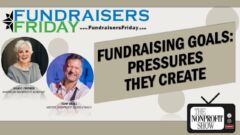
We take a no-fluff approach to unpacking the real, often unspoken stressors that nonprofit fundraisers face. Cohosts Julia C. Patrick and Tony Beall dissect why development teams are overwhelmed—and what can be done about it.
This episode isn’t just a venting session—it’s a strategic reality check. It challenges nonprofit leaders to re-evaluate their expectations, timelines, and tech support, and to build internal systems that actually empower fundraisers.
Tony kicks things off with clarity: “Goal setting has to be done around data, history, and trends. It’s about future forecasting that’s actually grounded in reality.” He and Julia tackle a shared frustration: goals imposed from the top down with no involvement from development professionals. The conversation drills into how unrealistic fundraising targets, particularly when arbitrarily increased by boards or leadership, can lead to burnout, disengagement, and even job insecurity.
Julia adds, “We can’t just say, ‘Here’s the goal. OK, bye.’ We have to understand how to get there and why it matters.” From her candid recount of a story about a decades-long trust manager being asked to speak at clients’ funerals, Julia drives home that real donor relationships take time—and too often, organizations don’t allow that time.
Another sharp critique centers on short fundraising timelines. Tony explains that when leadership procrastinates or underestimates the runway required, it places unfair and urgent pressure on development teams. He urges organizations to share that burden across leadership—not just pile it onto fundraisers’ shoulders.
They also break down the communication chasm between marketing and development. As Tony states, “Marketing tells the story, but development and programs create it.” You’ll see how he argues that both departments should fall under the same leadership umbrella to ensure cohesive strategy and a united donor experience.
A particularly powerful segment looks into the anxiety of job security when unrealistic goals are not met—something many fundraisers silently battle. Tony shares a story from South Florida where a seasoned fundraiser is facing impossible expectations with no organizational adjustment or empathy. Despite loving the mission, the fear of being let go is real.
The fast-paced dialog concludes with a powerful call to action: invest in the tools that support development. Whether it's CRM systems, AI platforms, or community foundation grants, fundraisers need the infrastructure to succeed. Tony suggests “Don’t feel guilty about investing in tools. These are vital for serving your community better.”
00:00:00 Welcome and weekly reflections
00:03:30 Unrealistic fundraising goals—who sets them and why it matters
00:06:10 Advocacy tips for fundraisers when goals feel off-base
00:09:00 Short timelines and why they derail donor relationships
00:13:00 Long-term stewardship: donor loyalty through real connection
00:15:00 Job insecurity tied to missed goals—what’s at stake
00:19:00 Marketing and development: collaboration or chaos?
00:23:00 Reorganizing leadership to align marketing and fundraising
00:25:20 Why nonprofits must invest in tech tools and data systems
00:28:00 Community foundation grants and AI: accessible solutions
#FundraiserFatigue #NonprofitLeadership
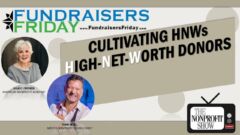
Our cohosts deliver a practical conversation on cultivating relationships with high net worth (HNW) donors. They explore how nonprofit organizations of all sizes can define what “high net worth” means in their context, identify aligned individuals, and thoughtfully steward them toward transformational giving.
Tony Beall opens with a foundational point: “We need to define what high net worth means for our own organization—because it looks different depending on your size, mission, and goals.” This nuance sets the stage for a broader conversation that deconstructs common assumptions about wealth and reminds nonprofit professionals that big gifts are rooted in deep, intentional relationships—not cold outreach.
Rather than chase only new wealth, Tony urges nonprofits to begin by mining existing donor data. “Let’s start with who already cares about our mission. We can often elevate those relationships before even casting a wider net,” he shares. The advice is practical and encouraging, especially for smaller teams with limited capacity.
Julia Patrick and Tony also touch on the human side of fundraising—empathy, trust, and consistency. Julia shares a personal story about securing her first $1 million donation, which came not over a fancy lunch, but at a modest cafeteria. “He told me he had grown up without enough to eat, and seeing all that food reminded him of how far he’d come. For him, that was luxury,” she recounts. It’s a moving reminder that motivations are deeply personal—and often surprising.
From prospecting strategies like leveraging SEC filings, Google Alerts, and local business journals to understanding the long timelines involved in major gift cultivation, the episode offers a balanced blend of emotional intelligence and tactical guidance.
As Tony puts it, “Patience and consistency are what build trust—not just with donors, but with the broader community.” And that trust, over time, is what unlocks major gifts.
00:00:00 Welcome to Fundraisers Friday
00:00:20 Julia praises Tony's impact on the sector
00:02:00 What does “high net worth” really mean?
00:03:50 Why your organization needs its own HNW definition
00:07:05 Start with your current donors
00:10:15 Tools for identifying HNW prospects
00:13:20 Using local journals and social registers
00:18:10 Understanding donor motivations
00:22:00 A powerful story about humility and generosity
00:23:30 The two-year major gift timeline
00:26:00 How trust drives long-term giving
00:29:00 Closing thoughts and sponsor thank you
#MajorGiftStrategy #DonorEngagement #NonprofitLeadership
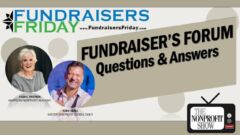
this session of Fundraisers Friday bubbles over with wit and wisdom from cohosts Julia C. Patrick and Tony Beall. Tackling real-world fundraising dilemmas, the duo dives into sticky questions nonprofits often tiptoe around.
We kick off with a sparkling debate: when a donor grows from a small supporter to a major one, who "owns" the relationship? Tony reminds us, “Relationships come first. Structure comes second.” His point: when a fundraiser elevates a donor’s giving, the organization should also elevate the fundraiser’s role. Julia reflects, “I didn’t think of it that way… they should be elevated—and they haven’t been.”
Next up: corporate crossover. What happens when an individual donor brings their business into the giving picture? Should the relationship transfer to the corporate team? Tony weighs in: “The development professional may not have the skill sets for corporate partnerships. So, invest in training—or consider a strategic handoff.”
Then comes the glitzy question—exclusive events for high-net-worth donors. Are these smart strategies or community-killers? Tony, a champion of inclusivity, says, “Exclusivity has its place… if it leads to planned giving and legacy conversations.” Julia adds in, saying how savvy orgs are shifting these events toward behind-the-scenes access and thought leadership rather than fancy galas.
They wrap with the boardroom. Should fundraisers speak at board meetings? Tony suggests quarterly appearances. “Your board should know the development team—if you see them in the grocery store, you should say hello!” Julia adds, “It’s not about asking for money. It’s about connection, introductions, and understanding.”
Packed with humor, heart, and practical advice, this fast-paced convo gives nonprofit professionals tools they can use—and some new ways to look at old problems.
00:00:00 Welcome
00:02:06 Who Owns a Donor: Structure vs. Relationship
00:03:18 Fundraiser Elevation Through Donor Growth
00:05:49 Corporate Sponsorship Conflicts
00:06:55 Managing New Corporate Gifts from Existing Donors
00:10:22 Exclusive Events for Top Donors
00:12:00 Are VIP Events Worth It?
00:18:12 Should Fundraisers Speak at Board Meetings?
00:24:24 Board Member Roles in Fundraising
00:27:30 Wrapping Up: Ask Questions, Share Freely
#FundraisersFriday #NonprofitLeadership #DonorRelationships

It’s Fundraiser’s Friday—and we engage in a candid, layered conversation about one of the sector’s least addressed yet most persistent realities: stress. Specifically, the stress experienced by nonprofit fundraisers who juggle mounting expectations, emotional labor, event overload, and relentless revenue goals.
Cohost Julia Patrick opens with a sobering observation: “We can’t, as a sector, keep fundraisers going. They burn out and leave—an average tenure of only 18 months.” This sets the tone for a deep dive into the sources of that burnout and practical frameworks to address them. Cohost Tony Beall offers a powerful, centering reminder: “Give yourself the grace and accept that you need these things for yourself. There’s no guilt in taking care of the caretaker.”
Together, they examine six categories of stress fundraisers commonly endure: revenue pressure, donor expectations, event management demands, campaign overload, internal organizational scrutiny, and peer isolation. Instead of simply bemoaning these conditions, the cohosts provide tactical insight. From outsourcing logistics and investing in professional benefit auctioneers, to building strong volunteer committees and peer support networks, they propose both mindset shifts and structural solutions.
Tony emphasizes the importance of open and honest communication—up, down, and across the organization—as one of the most effective antidotes to mounting stress. Equally essential, Julia insists, is understanding the often-forgotten emotional toll of donor relationships and campaign deadlines, which can be exacerbated by unrealistic leadership expectations or outdated traditions like “we’ve always done this event.”
What emerges is a roadmap for healing a profession at risk. This isn’t just an episode—it’s a resource, a reset, and a reaffirmation for nonprofit professionals who need permission and tools to stay in the work they love.
00:00:00 Welcome to Fundraisers Friday
00:01:00 Fundraiser burnout and short tenure
00:02:00 Revenue pressure and mental strain
00:05:00 Open communication as stress management
00:07:35 Donor relationships and expectation stress
00:10:00 Fundraisers as accidental event managers
00:13:15 Return on effort for fundraising events
00:16:00 Volunteer committees and shared ownership
00:18:10 Benefit auctioneers and event ROI
00:21:00 Campaign overload and tech tools
00:24:00 Internal scrutiny and team pressure
00:27:00 Peer support and professional associations
00:30:00 Final takeaways and call for self-care
Follow the ongoing conversation at #TheNonprofitShow
